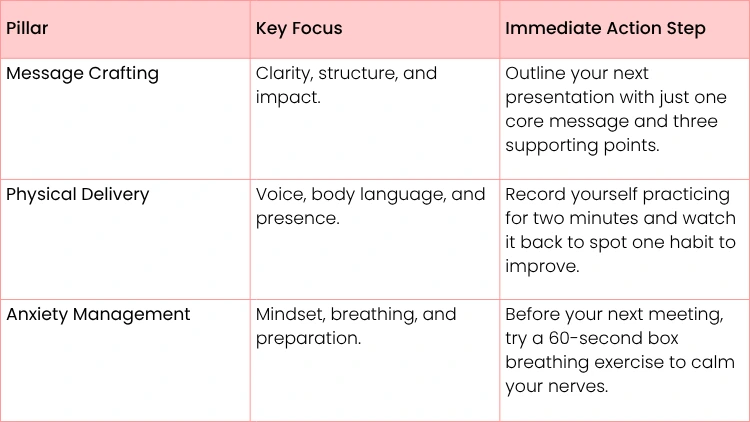How to Improve Public Speaking and Build Confidence

Improving your public speaking skills really boils down to three core pillars: crafting a clear message, mastering your physical delivery, and learning to manage that all-too-common performance anxiety. Real, lasting success comes from structured practice in these areas, which is great news—it means powerful speaking is a skill you can learn, not a talent you’re born with.
Finding Your Voice: A Practical Start
Staring down an audience can feel terrifying. If you feel overwhelmed just thinking about it, you’re in good company. The fear of public speaking is incredibly common—in fact, various surveys show that somewhere between 73% and 77% of people get nervous when speaking in front of a group. It’s a near-universal feeling.
But here’s the secret: powerful speakers don’t eliminate their nerves. They just learn how to channel that energy into something productive. This guide is designed to give you a direct, no-fluff framework to do exactly that. We’re moving beyond generic advice to give you actionable strategies you can start using today.
The Three Pillars of Improvement
To genuinely get better, you need a holistic approach. It’s not enough to just master one area. A speaker with a perfect message but awkward body language will struggle to connect, just like a confident delivery can't salvage a rambling, confusing speech.
Here are the pillars we'll build your skills upon:
- Strategic Message Crafting: Think of this as the blueprint for your speech. It’s about nailing your core idea, structuring your points logically, and making sure every single word serves a purpose.
- Mastering Physical Delivery: This is the how. How you say something is often just as important as what you’re saying. We're talking vocal variety, body language, purposeful gestures, and making real eye contact.
- Managing Performance Anxiety: This isn’t about pretending you're not nervous. It's about using practical techniques to calm your mind, reframe your thinking, and turn that shaky, anxious energy into focused excitement.
The goal is simple: to demystify the process and prove that great public speaking is something you can build, one step at a time. Small, consistent actions in these three areas lead to massive, lasting change.
Jump To Section

Earn As You Learn
Earn 25% commission when your network purchase Uplyrn courses or subscribe to our annual membership. It’s the best thing ever. Next to learning,
of course.
Your Public Speaking Improvement Roadmap
To give you a clearer picture, here's a quick roadmap of how these pillars fit together.
This table offers a snapshot of the essential pillars for transforming your public speaking skills, outlining the journey from initial preparation to continuous, confident growth.
This structured approach is your greatest ally. By breaking the challenge down into these smaller, more manageable pieces, you can make steady, tangible progress. Each pillar supports the others, creating a solid foundation for you to stand on every time you speak. And a huge part of this is mindset—building the confidence you need now for a brighter tomorrow is the essential first step that makes all the other skills stick.

Building a Message That Actually Connects
A powerful speech doesn’t just happen when you step onto a stage or log into a video call. The real magic happens long before that. The difference between a talk that gets forgotten and one that inspires action is all in the architecture of your message.
Too many speakers drown their audience in a sea of facts, figures, and endless slides. They lose sight of the one thing that truly matters: creating a genuine connection. This isn't about just listing your topics; it’s about crafting a narrative that clicks with people on both a logical and an emotional level.
Your first job? Boil your entire presentation down to a single, powerful idea.
Define Your One Core Message
Before you touch a slide or write a single sentence, you need to be able to finish this one: "The one thing I want my audience to remember, feel, or do after this is ______." This sentence is your North Star. It guides every single decision, helping you figure out what to include and—more importantly—what to cut.
Practical Example: Imagine you are presenting a new software tool to your team.
- Weak Core Message (Topic): "I'm going to explain the features of our new CRM software."
- Strong Core Message (Takeaway): "The one thing I want my team to do is start using the automated reporting feature in our new CRM to save themselves five hours of manual work each week."
See the difference? The second one has a purpose and a clear benefit for the audience.
Structure Your Ideas with a Proven Framework
Once you have your core message locked in, you need a way to build your points around it logically. One of the simplest and most effective frameworks out there is the “What? So What? Now What?” model. It’s brilliant because it forces you to connect information to its meaning, and then connect that meaning to a clear action.
Here’s the breakdown:
- What? This is your main point—the fact, the data, the core idea you're sharing.
- Actionable Insight: State it as clearly and simply as possible. Avoid jargon.
- So What? This is where the magic happens. You explain why this information matters to this specific audience. What are the implications for them? Why should they care?
- Actionable Insight: Use phrases like, "This is important to you because..." or "What this means for your team is..."
- Now What? This is your call to action. Based on everything you’ve just said, what should the audience do, think, or believe now?
- Actionable Insight: Make it specific and easy. Instead of "Let's be better", say "Open the app and try this one feature today."
This simple structure turns a data dump into a compelling argument. You’re not just sharing information; you’re giving it context and motivating your audience to act on it.
Applying the Framework in the Real World
Let’s see how this plays out in a couple of common scenarios.
Scenario 1: A 5-Minute Team Update
- Core Message: We need to pivot our focus to Client X this week to hit our deadline.
- What? Client X just moved up their launch date, which means we have five fewer days than planned.
- So What? Our current workflow won't cut it anymore. This puts the entire project at risk, and we can't afford to damage our relationship with a key client.
- Now What? For the next three days, everyone needs to pause work on secondary projects and go all-in on the final integration for Client X.
Scenario 2: A 30-Minute Client Pitch
- Core Message: Our platform is the only solution that solves your unique data security problem while saving your team valuable time.
- What? Let me start by showing you a demo of our patented encryption feature.
- So What? This directly addresses the compliance gaps you mentioned, protecting you from potential fines and messy data breaches.
- Now What? We’ll finish by outlining a simple, three-step implementation plan and propose a pilot program so you can see the results for yourself.
In both a short update and a longer pitch, the framework creates a clear, persuasive arc. Of course, a solid structure is just the beginning. To really keep your listeners engaged, check out this guide on how to captivate your audience when you speak in public. A great structure ensures your message isn't just heard—it's remembered and acted on.

Mastering Your Physical Delivery
Once you’ve nailed down a powerful message, the next challenge is to deliver it in a way that truly connects. Your body and your voice are the most powerful tools you have on stage, but they’re often the most neglected.
The truth is, your audience isn't just listening to your words; they're reading the non-verbal conversation you're having with them. What you do with your body can either amplify your message or completely undermine it.
This isn’t just about looking polished. Improving your physical delivery can have a direct, measurable impact on your career. Research shows that non-verbal communication—your body language, your tone—accounts for as much as 65% of your overall impact. It’s no surprise that 92% of professionals believe excellent presentation skills are vital for success at work.
Finding Your Voice (Literally)
Your voice is an instrument. It can build excitement, convey nuance, and drive home your most critical points. A flat, monotone delivery is the fastest way to lose an audience. To really command the room, you have to actively vary your vocal delivery.
It all comes down to experimenting with three key elements:
- Pace: This is the speed at which you speak.
- Actionable Insight: When explaining a complex idea, deliberately slow down. Then, when sharing a relatable story, speed up slightly to create energy.
- Pitch: Think of this as the high and low notes in your voice.
- Actionable Insight: Try raising your pitch slightly when you ask a question to engage the audience, and lowering it when you make a definitive statement to convey authority.
- Volume: Simple enough—how loud are you?
- Actionable Insight: Instead of just being loud, try dropping your volume to a near-whisper when sharing a surprising fact. This forces the audience to lean in and listen closely.
And don't forget the most powerful vocal tool you have: the strategic pause.
- Practical Example: After you share a key statistic like, "This change could increase our revenue by 20%", pause for a full two seconds. That silence gives your audience a moment to really process the impact and makes the point land with so much more weight.
Commanding the Stage with Your Body Language
Your physical presence can either reinforce your message or work against it. Confident, purposeful body language signals to your audience that you’re credible and in control.
Start from the ground up with your stance. Stand with your feet about shoulder-width apart, with your weight distributed evenly. This "power stance" doesn't just project confidence to others; it actually makes you feel more grounded and stable. This helps cut down on nervous fidgeting, swaying, or aimless pacing—all dead giveaways of anxiety.
Making Gestures and Eye Contact Count
The age-old speaker question: "What do I do with my hands?"
The answer is simple: use them with purpose. Your gestures should complement your words, not become a distraction.
- Practical Example: When you say, "We have three main priorities", hold up three fingers. When you talk about a large-scale project, use wide, open gestures. When discussing a specific detail, bring your hands closer together.
A good rule of thumb is to keep your gestures natural and within the "gesture box"—that's the area from your shoulders down to your waist. When you’re not actively gesturing, just let your hands rest comfortably at your sides. Try to avoid crossing your arms (which can read as defensive) or clasping your hands behind your back.
For a deeper dive, check out these actionable body language tips to help you make a strong impression.
Finally, make genuine eye contact.
- Actionable Insight: Instead of scanning the room like a security camera, try the "lighthouse" technique. Focus on one person on the left side of the room for a full sentence. Then, turn and do the same for someone in the middle, and then someone on the right. This makes individuals feel seen and creates a much stronger, more personal connection.

Turning Anxiety Into Your Ally
Let's be real for a moment. That pit-in-your-stomach, heart-pounding dread before a big speech? It's intense. If your palms get sweaty and your mind starts racing a million miles a minute, you're not just being dramatic—you're having a completely normal human reaction.
This feeling has a name: glossophobia. It's one of the most common social fears out there. In fact, a staggering 75% of people in the U.S. feel some level of anxiety about public speaking, and that trend holds true in most places around the world.
Here's the secret the pros know: you don't actually get rid of the fear. You learn to work with it. The goal is to channel that nervous energy from a destructive force into a powerful ally. Your body is just gearing up for a big moment, and that's something you can learn to use to your advantage.
Reframe Your Mindset From Fear to Excitement
Think about the physical signs of anxiety—a racing heart, quicker breathing, that jolt of adrenaline. Now, think about the signs of pure excitement. They're almost identical, aren't they? The only thing separating them is how you label the feeling in your head.
- Actionable Insight: The next time you feel nervous, say this specific phrase out loud: "My body is giving me energy to perform well". This isn't just playing mind games. When you relabel the emotion, you can flip your body’s reaction from a threat response (fight or flight) to a challenge response.
- Practical Example: Imagine you're about to give a quarterly review. Instead of thinking, "I'm so nervous they'll judge my numbers", reframe it as, "I'm excited to finally showcase all the incredible work my team has done". That small pivot can completely change your emotional state.
Use Your Breath as an Anchor
When anxiety takes over, our breathing gets shallow and fast, which just amps up the panic. One of the quickest and most effective ways to hit the brakes on your nervous system is to take control of your breath.
The box breathing technique is a lifesaver. It’s simple, discreet, and you can do it anywhere—even sitting in your chair just moments before you’re called up.
Here’s how it works:
- Inhale slowly through your nose for a count of four.
- Hold your breath at the top for a count of four.
- Exhale slowly through your mouth for a count of four.
- Hold the empty breath for a count of four.
Just a few cycles of this—maybe three to five times—can regulate your heart rate and send a powerful signal to your brain that everything is okay. For those crucial minutes before you step on stage, having a few go-to strategies to calm down before a presentation can make all the difference.
Pre-Speech Grounding Checklist
We’ve found that having a consistent routine in the 15 minutes before we speak is absolutely critical. It’s not about cramming notes; it’s about grounding ourselves and getting centered.
Your pre-speech routine is your personal launch sequence. It’s designed to quiet the noise, sharpen your focus, and put you in the optimal state of mind to connect with your audience.
Here’s a simple checklist to use that you can adapt for yourself:
- Find a quiet corner: Even if it's just for a few minutes, step away from the buzz. A restroom stall or an empty hallway works perfectly.
- Do three cycles of box breathing: A quick reset for your nervous system.
- Visualize a win: Close your eyes and vividly imagine yourself delivering your opening lines with confidence. See the audience nodding along, engaged and interested. Picture the applause at the end.
- Glance at your opener and closer: Don't reread the whole thing. Just solidify how you'll start strong and end with impact.
- Take a sip of water: A dry mouth just adds another layer of stress you don't need. Room temperature water is best.
This little toolkit can build a powerful buffer against that overwhelming wave of anxiety. To dig deeper into this, you might find this guide on five tips for overcoming public speaking anxiety really helpful.
How to Practice for Real Improvement
You’ve probably heard the old saying, "practice makes perfect". When it to comes to public speaking, that’s only half the story. The truth is, deliberate practice makes perfect.
One of the biggest traps speakers fall into is passively reading their slides over and over. Let's be clear: that’s not practice. It’s a review session, and it does next to nothing to build the muscle memory you need to deliver a compelling talk.
Real rehearsal is an active, structured process. The aim isn't just to memorize your lines—it's to internalize your message. Once you’ve truly absorbed the content, you can speak from a place of authentic confidence, ready to adapt to anything that comes your way.
Moving Beyond Just Reading Your Slides
To get better, you have to get the words out of your head and into the room. Your brain simply processes information differently when you speak it aloud compared to when you just think it. This is where the real work begins.
Your first step? Record yourself. This is completely non-negotiable.
Grab your phone, set it up, and record a full run-through of your talk—video and audio. Yes, it will feel awkward watching it back. Push through that discomfort, because it's the single best source of objective data you'll get.
When you review your recording, play detective and look for specifics:
- Filler Words: Count every single "um", "ah", "like" and "you know".
- Actionable Insight: Keep a running tally on a notepad. Seeing the number in black and white is a powerful motivator.
- Pacing and Pauses: Are you rushing through your most important points?
- Actionable Insight: Use a stopwatch to time a specific section. If you're covering a key point in 10 seconds, try delivering it again in 20 to force yourself to slow down.
- Body Language: What are your hands doing? Are they making purposeful gestures, or are they nervously fidgeting in your pockets? Is your posture broadcasting confidence?
This self-assessment gives you a clear, honest baseline. Now you have specific things to work on for your next practice session.
Simulating the Real Environment
The closer you can make your practice space feel like the real stage, the better prepared you'll be. You’re not just training your mouth to say the right words; you’re training your whole body for the physical experience of presenting. Think about the little details.
- Practical Example: If you'll be using a slide clicker for your presentation, buy one for a few bucks online and practice with it. It’s a small thing, but it prevents you from fumbling with unfamiliar tech when the pressure is on.
Your goal is to make the actual performance feel like just another rehearsal. By removing as many unfamiliar variables as possible, you lower your cognitive load and free up mental space to connect with your audience.
Here are a few simple ways to simulate the real deal:
- Stand Up: Never practice sitting down if you’ll be standing up for the real thing. Get on your feet.
- Wear Your "Game Day" Outfit: Practice in the actual clothes and shoes you plan to wear. You might discover those new shoes are incredibly squeaky or that jacket is too restrictive.
- Use Your Visuals: Don't just glance at your slides on your laptop. Project them onto a wall or a TV screen and practice with them in your line of sight.
Managing anxiety is another key part of practice. This simple framework can help you get your mind right before a rehearsal or the main event.
Weaving these mental tools into your routine—reframing nerves as excitement, breathing deeply, and visualizing success—is a powerful way to build unshakable confidence.
Structuring Your Practice Schedule
Not all practice is created equal. To see tangible progress, you need to understand the difference between just going through the motions and engaging in deliberate, effective rehearsal.
Effective vs. Ineffective Practice Methods
By focusing on the effective column, you shift from passive review to active, purposeful rehearsal that builds real skill and confidence.
Spreading your practice out over several days is also far more effective than one frantic, last-minute cram session. This approach, known as spaced repetition, helps lock the material into your long-term memory. For more in-depth guidance, you can explore expert tips on how to rehearse and practice to stand out as a master speaker.
Remember, every deliberate practice session transforms rehearsal from a tedious chore into your most powerful tool for becoming a confident, impactful speaker.

Frequently Asked Questions
As you start putting these techniques into practice, you’re bound to run into some specific challenges. It happens to everyone. Here are the answers to a few of the most common questions we hear from speakers trying to level up their game.
How Can I Stop Using Filler Words Like Um and Ah
First, you have to realize you’re doing it. The easiest way? Record yourself. Just pull out your phone and talk for a few minutes. Listening back can be a real eye-opener when you hear how many times "um", "ah", "so" and "like" sneak in.
The single best tool to kill filler words is the strategic pause. The moment you feel an "um" bubbling up, just stop. Take a breath. It feels like an eternity to you, but to your audience, it just looks like you're collecting your thoughts. It makes you sound composed, not nervous.
- Actionable Insight: Try this drill. Talk about a simple topic—your favorite movie, what you did last weekend—for 60 seconds straight without a single filler word. If one slips out, you have to start the timer over. This exercise literally retrains your brain to embrace silence instead of filling it with noise.
What Is the Best Way to Memorize a Speech Without Sounding Robotic
Here’s the secret: don't. At least, not word-for-word. Trying to memorize an entire speech verbatim is a recipe for disaster. You end up sounding stiff and unnatural because your brain is busy trying to recall exact phrases instead of actually connecting with the people in front of you.
Your real goal is to internalize your key ideas and the logical path you're taking your audience on.
- Actionable Insight: Instead of a full script, create an outline with just 3-5 keywords for each main point. For example, a point about marketing strategy might just have the keywords: "Social Media", "Engagement" and "Q3 Goals". Practice your talk using only those keywords as your guide. This forces you to find the words in the moment, making your delivery feel conversational and authentic every single time.
A pro tip: We do recommend memorizing two parts of your speech perfectly: your opening and your closing. Nail the first 30 seconds to grab their attention and stick the landing with a powerful, rehearsed final line. The middle part can and should be more flexible.
How Do I Handle Unexpected Questions or Interruptions
Staying calm is everything. When an unexpected question comes your way, your first job is to simply listen. Don't jump ahead and start planning your answer while they're still talking—just absorb what they're asking.
A brilliant little tactic is to repeat or rephrase the question back. Something like, "So, if I'm hearing you right, you're asking about the budget implications for next quarter?" This move is a game-changer. It does three things at once:
- It confirms you understood them correctly.
- It buys you a precious few seconds to organize your thoughts.
- It makes sure everyone else in the room heard the question.
If you know the answer, deliver it concisely and then smoothly guide the conversation back to your presentation.
- Practical Example: "That's a great question. The short answer is that all budget implications are outlined in the appendix, and that actually brings me to my next point about our resource allocation..."
And if you don't know the answer? Admitting it is a power move. Saying, "That's a very specific question, and I don't have that data on hand. Let me find out and get back to you," shows incredible confidence and honesty. It builds far more trust than trying to bluff your way through. For a deeper dive into this and other topics, you can explore more strategies to improve public speaking and build confidence.
At Uplyrn, we believe that confident communication is a skill anyone can build. Our platform connects you with expert coaches and courses designed to help you master public speaking, from crafting your message to delivering it with impact. Ready to find your voice? Explore our courses at Uplyrn and start your journey today.


Leave your thoughts here...
All Comments
Reply